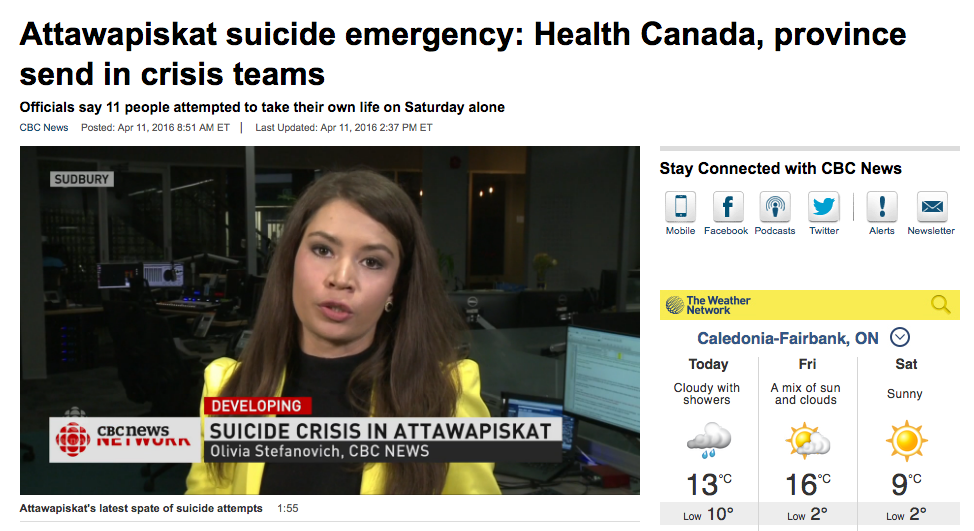By Donald Teuma-Castelletti
When CBC multimedia journalist Olivia Stefanovich stepped off the plane in Attawapiskat, Ont., on Monday, April 11, she had no idea what to expect. She had reported about the Cree reserve before from her home base in Sudbury, Ont., but she had yet to visit it.
But over the weekend, 11 young people had attempted suicide and Chief Bruce Shisheesh and the council had declared a state of emergency. Stefanovich knew she would immediately need to make a connection and build the trust of the children and adults alike in order to report on the problems the community faced.
“When I went there, I didn’t see any physical evidence of a crisis,” said Stefanovich. “I feel like the issues were more behind closed doors.”
So, for the three days she was there, she adopted a routine. Each morning she would be up at 6 a.m. to prepare a Q & A for the news network, debrief with her morning show, Morning North, perhaps pop into a Thunder Bay radio broadcast and deal with a lot of technical problems, like weak to no cell service.
The local hotel, Wolf Lodge Inn, was full, so she stayed at a two-bedroom wood-paneled home towards the centre of the community, as recommended by the hotel operators. The living room became another CBC bureau for other CBC reporters that arrived a bit later, since they mostly couldn’t get access to Wi-Fi in their makeshift office.
Our lovely place in #Attawapiskat that’s become a temp bureau for CBC reporters. All our stories are sent from here. pic.twitter.com/LW86mVZQXB
— Olivia Stefanovich (@Ostefanovich) April 13, 2016
But the bulk of her time and effort was spent getting to know the community so she could tell their stories. This involved attending the emergency meetings where people expressed the need for more youth-oriented hang-outs or the need for plans to curb the addiction problems.
And people took notice of her. She wanted to report their story fully and accurately—not just grab quotes and run off—so she tried hard to be present. Soon she found people coming up to her and wanting to speak to her.
She also got to work making solid connections with individuals. For instance, Stefanovich reached out to 13-year-old Amy Hookimaw who had posted on Facebook about adults who needed to listen to their children.
“She said that there were all of these young people messaging her or talking to her, who were explaining ways that they wanted to commit suicide, or they were saying, ‘I feel so depressed,’ and she said it was kind of rampant,” said Stefanovich. “People as young as six even and grade fours, grade fives, grade sixes.
“And it was like, oh my God, how could this be happening here?”
Hookimaw explained to Stefanovich that she felt depressed and had considered suicide before. But when she saw her own mom crying when she told her about these thoughts, it made her stop. Hookimaw has now become a young leader in trying to help with the crisis.
Stefanovich also thinks that because she is a young reporter—she’s only been working in the field since she graduated from Ryerson University’s journalism program in 2013—the girls and the teenagers she met were more curious than intimidated by her. That helped them trust her.
“There was a prayer walk on Tuesday evening, and that went on for about an hour,” she said. About 400 people walked around the community with a police escort and Stefanovich stayed with them the entire time. There, she met two 13-year-old girls.
“I had just got there when they came up to me and actually walked with me for most of the way,” she said. “And that helped to develop relationships, because I could talk to them about what they do when they’re not in school.”
They also talked with her about the struggles their parents and grandparents face. “You could get a sense of how complicated the issues are,” she said. “Because it’s not just one thing, it’s a lot of these long-standing issues, with a lot of it stemming from the residential schools.”
“It isn’t easy for people to open up about suicide attempts. There are so many angles to cover and people to speak to about it,” she added. “On top of this, there was a lot of misinformation out there from other media reports. I don’t think it’s possible to feel like I covered everything I wanted to.”
Now that she’s made a connection with the community, she feels it an obligation to maintain her connections with her sources and continue to keep on top of the story.
Celebratory bonfire for the youth in Attawapiskat on Wednesday evening. #jamesbay #coast #northernOntario pic.twitter.com/NcfR3k0IdY
— Olivia Stefanovich (@Ostefanovich) April 16, 2016
“Attawapiskat is a place that I’ve always covered from a distance in Sudbury, so I feel like this assignment has helped me understand the community better and it has helped me develop sources that I will keep as we report on stories from the community moving forward,” said Stefanovich.
Nice to see this in person after covering the opening almost two years ago from Sudbury. #cbcsby #Attawapiskat pic.twitter.com/LDr6NQ7MlR
— Olivia Stefanovich (@Ostefanovich) April 12, 2016
[[{“fid”:”5868″,”view_mode”:”default”,”fields”:{“format”:”default”,”field_file_image_alt_text[und][0][value]”:””,”field_file_image_title_text[und][0][value]”:””},”type”:”media”,”link_text”:null,”attributes”:{“height”:442,”width”:640,”style”:”width: 100px; height: 69px; margin-left: 5px; margin-right: 5px; float: left;”,”class”:”media-element file-default”}}]]Donald Teuma-Castelletti will graduate from Algonquin College’s journalism program this spring. He is currently doing his field placement at Pacific Yachting magazine in Vancouver.

